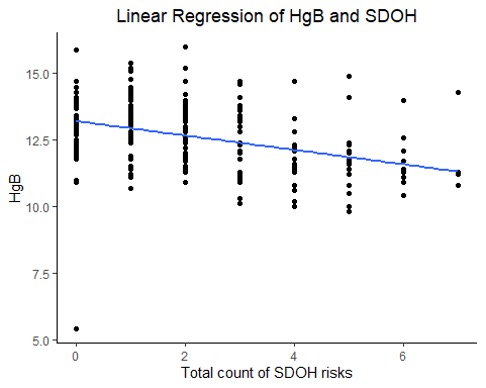Health Equity/Social Determinants of Health 7
Session: Health Equity/Social Determinants of Health 7
749 - Predicting Anemia through Social Determinants of Health Screening in Pediatric Patients in a Primary Care Setting
Sunday, April 27, 2025
8:30am - 10:45am HST
Publication Number: 749.6425
Julia Hoffman, University of Florida College of Medicine, Merritt Island, FL, United States; Molly Posa, University of Florida, Newberry, FL, United States; Jaclyn Otero, UF Health Shands Children's Hospital, Gainesville, FL, United States; Cynthia Garvan, University of Florida College of Medicine, Gainesville, FL, United States; Maria Kelly, University of Florida College of Medicine, Gainesville, FL, United States

Julia B. Hoffman, BA (she/her/hers)
Medical Student
University of Florida College of Medicine
Merritt Island, Florida, United States
Presenting Author(s)
Background: Social determinants of health (SDOH) may contribute to anemia by influencing a person’s well-being and access to resources. Identifying whether SDOH can predict an increased risk of anemia may enable earlier detection and treatment. Noninvasive transcutaneous hemoglobin testing (tcHgb) using the Pronto Pulse Co-Oximeter is a validated method for assessing hemoglobin in pediatric patients.
Objective: To determine if specific SDOH domains are predictive of a higher risk of anemia in pediatric patients in ambulatory care settings.
Design/Methods: Pediatric patients ( < 18 years) and their parents or legal guardians presenting to primary care clinics for routine or acute visits were invited to participate. After obtaining consent, parents or guardians completed a validated SDOH screener assessing key social determinants, and a tcHgb measurement was obtained on each child. A retrospective chart review was conducted to gather demographic and clinical data. Relationships between numeric variables (e.g., age, BMI) and tcHgb were tested with Spearman correlations. Relationships between categorical variables (e.g., sex) and tcHgb were tested with Wilcoxon rank sum tests. A regression analysis with tcHgb as the outcome variable and a count of SDOH risks as the explanatory variable was conducted. All analysis was performed using SAS software v 9.4 (Cary, NC). The level of significance was set at .05.
Results: A total of 248 families participated in the study. Among the children, 60 patients (24.19%) had at least one identified social need, with the most common needs being Financial Strain (31.85%), Food Insecurity (25.00%), Cognitive Disabilities (21.77%), Language and Literacy (21.05%), and Mental Health concerns (18.11%). The mean (SD) tcHgb was 12.65 (1.3) g/dL. The median [Q1, Q3] count of SDOH risks was 2.0 [0.5, 3.0]. There was no association between tcHgb and age, BMI, or sex. In the regression analysis, each additional positive SDOH concern was associated with a 0.27 g/dL decrease in tcHgb (p < .0001).
Conclusion(s): A significant association exists between SDOH and lower hemoglobin levels in pediatric patients, indicating that factors such as Financial Strain, Food Insecurity, and Cognitive Disabilities contribute to an elevated risk of anemia. Each additional SDOH concern correlated with a measurable decrease in tcHgb, underscoring the cumulative impact of social needs on health outcomes. These findings highlight the importance of early SDOH screening as a predictive tool for anemia, with potential to enhance clinical outcomes in pediatric care settings.
Figure 1. SDOH Risk Counts as Predictors of HgB Levels


